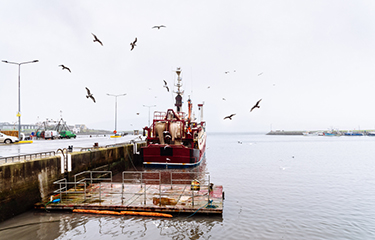The United Kingdom is no longer the second-biggest export market for Irish seafood, according to a recent report from Bord Iascaigh Mhara (BIM) Business of Seafood.
The distinction now belongs to Asia, with exports of Irish seafood to the region increasing by 23 percent to EUR 96 million (USD 108 million) in 2018, BIM noted. Meanwhile, in the same year, the value of seafood exports from Ireland to the U.K. fell by 4 percent to EUR 81 million (USD 91.1 million), predominantly attributed to a decrease in the value of sterling, Irish newspaper Donegal Now reported.
Ireland’s overall seafood sector grew by 3.4 percent in 2018, BIM said, achieving a value of EUR 1.25 billion (USD 1.4 billion) in GDP terms. BIM CEO Jim O’Toole told Donegal Now that private investments (EUR 267 million, USD 300 million) and government support (EUR 170 million, USD 191.2 million) were in large part to thank for the sector’s recent growth.
“Investment is happening at every level of the sector from investment in new fishing gear, improvements to vessels to make them more sustainable, to capital investment in processing industries. The sector has been responding to a challenging environment. Despite the continued uncertainty brought about by Brexit there’s still an underlying confidence in the sector as evidenced by the growth of investment,” O’Toole said.
Comprised of 14,359 people working across the fishing, aquaculture, processing, and retail sectors, Ireland’s seafood industry has proven particularly important for the country’s coastal communities, according to Donegal Now. In Donegal alone, 12 percent of employment comes from the seafood industry, the newspaper said.
The value of trade for Irish seafood decreased by 4 percent in 2018 due to reduced volumes of species like mackerel and salmon. Salmon production in the country plunged by 30 percent, a decrease attributed to the cyclical nature of Irish salmon production that allows sites to remain fallow or vacant for a period of time between production cycles, according to BIM and Donegal Now. As for mackerel, quota fluctuations resulted in a 10 percent decrease in the value of the species in response to reduced landings.
The BIM report recounts the Irish fishing fleet’s journey over the past decade, including the economic downturn experienced from 2008 until 2013, as well as the significant increase in fuel prices experienced in 2008 and again between 2011 and 2014. The fleet’s gross profit has risen to EUR 78.1 million (USD 87.8 million) in 2018, from a low of EUR 10.4 million (USD 11.7 million) seen in 2010.
“The Irish seafood sector is noted for its resilience and ability to adapt to changing political and socio – economic circumstances," the BIM report said. "The significant increase in exports to Asia over the last five years by 247 [percent] demonstrates the strength and diversification of the sector."







